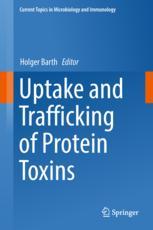Uptake and Trafficking of Protein Toxins 2017
دانلود کتاب پزشکی جذب و تجارت سموم پروتئینی
| نویسنده |
Holger Barth |
|---|
| تعداد صفحهها |
256 |
|---|---|
| نوع فایل |
|
| حجم |
5 Mb |
| سال انتشار |
2017 |
89,000 تومان
این جلد بر انتقال پروتوتوکسینهای باکتریایی مرتبط با پزشکی به سلولهای پستانداران و استراتژیهای دارویی جدید برای جلوگیری از جذب سم تمرکز دارد. فصل های اول درک فعلی ما از گیرنده های سطح سلولی و فرآیندهای انتقال سلولی نوروتوکسین ها، سموم کلستریدیوم بوتولینوم، انتروتوکسین های دوکفه ای کلستریدیوم، سموم سیاه زخم و سموم دیفتری را بررسی می کنند. به طور خلاصه، زیرواحدهای خاص اتصال/حمل (B) زیرواحدهای آنزیمی (A) را به سیتوزول میرسانند، جایی که دومی بسترهای خود را تغییر میدهد و منجر به اثرات سیتوتوکسیک و بیماری مرتبط با سموم مشخص میشود. مکانیسمهای اصلی برای انتقال زیرواحدهای A از اندوزومها به سیتوزول و نقش منافذ غشایی تشکیلشده توسط زیرواحدهای B و چاپرونهای سلول میزبان برای این فرآیند بررسی میشوند. فصلهای پایانی کتاب بر روی ترکیباتی تمرکز دارد که از انتقال زیرواحدهای A از اندوزومها به داخل سیتوزول جلوگیری میکند و بنابراین ممکن است به استراتژیهای درمانی جدیدی برای بیماریهای مرتبط با سموم منجر شود. این مواد شامل بازدارنده های دارویی چاپرون های سلول میزبان مربوطه و همچنین مولکول های چند ظرفیتی و هتروسیکلیک هستند که به طور خاص کانال های انتقال سم را مسدود می کنند. این جلد منبعی به روز برای محققان فراهم می کند.
This volume focuses on the transport of medically relevant bacterial protein toxins into mammalian cells, and on novel pharmacological strategies to inhibit toxin uptake. The first chapters review our current understanding of the cell-surface receptors and cellular transport processes of Clostridium botulinum neurotoxins, Clostridium botulinum C3 toxin, Clostridium difficile toxins, binary clostridial enterotoxins, anthrax toxins and diphtheria toxin. In brief, specific binding/transport (B) subunits deliver the enzyme (A) subunits into the cytosol, where the latter modify their substrates, producing cytotoxic effects and the characteristic toxin-associated diseases. Key mechanisms for the transport of the A subunits from endosomes into the cytosol and the role of trans-membrane pores formed by the B subunits and host cell chaperones for this process are reviewed. The book’s closing chapters focus on compounds which inhibit the transport of the A subunits from endosomes into the cytosol and therefore might lead to novel therapeutic strategies for toxin-associated diseases. These substances include pharmacological inhibitors of the host cell chaperones involved, as well as multivalent and heterocyclic molecules that specifically block the toxins’ translocation channels. This volume offers an up-to-date resource for scientists.




